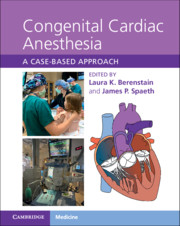Book contents
- Congenital Cardiac Anesthesia
- Congenital Cardiac Anesthesia
- Copyright page
- Dedication
- Contents
- Contributors
- Introduction
- Chapter 1 A Congenital Heart Disease Primer
- Section 1 Left-to-Right Shunts
- Section 2 Right-Sided Obstructive Lesions
- Section 3 Left-Sided Obstructive Lesions
- Section 4 Complex Mixing Lesions
- Chapter 21 d-Transposition of the Great Arteries (Arterial Switch)
- Chapter 22 d-Transposition of the Great Arteries (Atrial Switch)
- Chapter 23 l-Transposition of the Great Arteries (“Corrected” Transposition)
- Chapter 24 Total Anomalous Pulmonary Venous Return and Heterotaxy Syndrome
- Chapter 25 Truncus Arteriosus
- Section 5 Single-Ventricle Physiology
- Section 6 Heart Failure, Mechanical Circulatory Support, and Transplantation
- Section 7 Miscellaneous Lesions and Syndromes
- Index
- References
Chapter 23 - l-Transposition of the Great Arteries (“Corrected” Transposition)
from Section 4 - Complex Mixing Lesions
Published online by Cambridge University Press: 09 September 2021
- Congenital Cardiac Anesthesia
- Congenital Cardiac Anesthesia
- Copyright page
- Dedication
- Contents
- Contributors
- Introduction
- Chapter 1 A Congenital Heart Disease Primer
- Section 1 Left-to-Right Shunts
- Section 2 Right-Sided Obstructive Lesions
- Section 3 Left-Sided Obstructive Lesions
- Section 4 Complex Mixing Lesions
- Chapter 21 d-Transposition of the Great Arteries (Arterial Switch)
- Chapter 22 d-Transposition of the Great Arteries (Atrial Switch)
- Chapter 23 l-Transposition of the Great Arteries (“Corrected” Transposition)
- Chapter 24 Total Anomalous Pulmonary Venous Return and Heterotaxy Syndrome
- Chapter 25 Truncus Arteriosus
- Section 5 Single-Ventricle Physiology
- Section 6 Heart Failure, Mechanical Circulatory Support, and Transplantation
- Section 7 Miscellaneous Lesions and Syndromes
- Index
- References
Summary
Levo-transposition of the great arteries is a rare anomaly, comprising less than 1% of all forms of congenital heart disease and is characterized by both atrioventricular and ventriculoarterial discordance. Despite ventriculoarterial discordance, oxygenated and deoxygenated blood flow is in the correct physiologic direction, resulting in normal oxygenation and perfusion. Patients without other structural cardiac defects are asymptomatic at birth and during early childhood and usually present later in life. The long-term sequelae of patients with uncorrected levo-transposition include right ventricular dysfunction, systemic atrioventricular valve regurgitation, congestive heart failure, arrhythmias, and complete heart block. The natural history of the disease is largely determined by the presence of associated anatomic cardiac abnormalities and the progressive dysfunction of the morphologic right ventricle as the systemic pump. This chapter details the anesthetic management of a patient with levo-transposition presenting for an urgent appendectomy, including management of a pacemaker.
Keywords
- Type
- Chapter
- Information
- Congenital Cardiac AnesthesiaA Case-based Approach, pp. 158 - 168Publisher: Cambridge University PressPrint publication year: 2021



